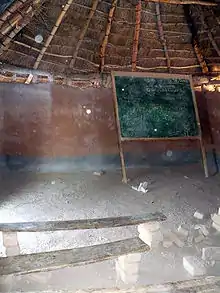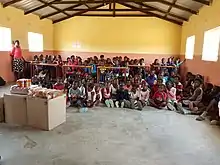Education in Zambia
Lower education in Zambia is divided into three levels; primary, junior secondary and upper secondary. Higher education in Zambia has improved in the recent years due to the increase of private universities and colleges. The biggest university is the public University of Zambia[1] which is located in the capital Lusaka. Then there are many other smaller universities, some public others private including Texila American University, Copperbelt University, Zambia Open University, European University Zambia Zambia Catholic University, Cavendish University, Zambia Adventist University, Northrise University, University of Lusaka, Lusaka Apex Medical University, Woodlands University College, Copperstone University College, University of Barotseland, University of Africa, Information and Communication University, Mulungushi University, Kwame Nkrumah University of Education and there are various Health training Institutes offering Diplomas in clinical medicine, Registered Nursing[2]

Early Childhood Education (ECE), Primary and secondary education
Primary Education in Zambia is the foundation of every one who gets into school, going from grade 1 – 7 with students then expected to pass the exams set by the Examination Council of Zambia[3] at the end of the grade 7 school year. Primary schools are spread in all parts of the country. Zambia has close to 110 Districts. Primary schools are owned by the government, the private sector and communities. Teachers work there voluntarily or for small stipends, unless these schools are sponsored by charities. Some community schools charge significant fees and resemble low-end private schools, but most are very cheap and cater to pupils for whom the local government school is too far away or imposes unaffordable costs such as uniforms.
With the exception of a few top private schools, Zambian schools are chronically under-resourced and educational standards extremely low.
Schooling falls into the following levels:
- ECE, preschool and reception
- Primary, grades 1–7
- Junior Secondary, grades 8–9
- Senior Secondary, grades 10–12
Upon completion of primary school, you can hopefully get directly into a secondary school (Secondary schools offer education from grade 8–12)- unfortunately there are areas in Zambia that have no secondary schools, efforts have been made and they have basic schools. Traditionally, grades 8–9 were part of Basic school. This allowed pupils unable to access secondary school to continue their schooling up to Grade 9, and provides primary schools with additional income (as government schools are allowed to charge fees to Gardes 8 and 9). In rural areas some pupils move long distances to access primary education and this has been a disadvantage in the fight to educating the future generation.
Education system

The Education system in Zambia is that of four levels:
Early Childhood Education level
- preschool.
- Reception. (no National exam.)
Primary level
- Grade 1 to 7.
- Education at this level is free at all governments schools. (National exam.)
Junior Secondary
- Grade 8 to 9.
- Theoretically free but many requirements
Senior Secondary
- Grade 10 to 12.
- Fee paying and final national exam at Grade 12.
- Education system GCSE.
- ASAT at grade 9
Higher education
In Zambia, there are three government universities and several technical schools that provide higher education. The Ministry of Science Technology and Vocational Training (MSTVT) in Zambia was also developed in 1992 to foster growth in technological fields.[4] Educational opportunities beyond secondary school are limited in Zambia. After secondary school, students mostly study at the various colleges around the country. Normally they all select students on the basis of ability; competition for places is intense.
The introduction of fees in the late 1990s has made university level education inaccessible for some, although the government does theoretically provide state bursaries. Copperbelt University opened in the late 1980s, taking over most of the former Zambia Institute of Technology site in Kitwe.[5] There are also several teacher training colleges offering two-year training programmes, while mission hospitals around the country offer internationally acceptable training for nurses. Several Christian schools offer seminary-level training.
There are three main universities and several others:
- University of Zambia (UNZA)
- Texila American University Zambia (TAU)
- Mulungushi University (MU)
- Copperbelt University (CBU)
- DMI St. Eugene University (DMISEU)
- University of Lusaka (UNILUS)
- Cavendish University Zambia (CUZ)
- Lusaka apex Medical University (LAMU)
- Zambia Open University (ZOU)
- Woodlands University College
- Kwame Nkrumah University (KWANU)
- University of Africa (UOA)
- University of Barotseland
- Information and Communication University (ICU)
- Mukuni University (MU)
- Eden University
- Kitwe College University of Education
- Africa Research University (ARU)
Additional Centres of Higher Education:
Apart from this universities and colleges, the country has also one of the oldest college offering distance education. Zambia College of Distance Education (ZACODE) formerly National Correspondence College has been in existence since 1963. The College had started from Evelyn Hone College then transferred from Lusaka to Luanshya. The college used to have 30000 learners and current crop of leaders in various institutions benefited from the materials the college produced and has continued to produce. Colleges and universities offering distance education must engage the college to help them improve on the distance materials being offered so that they become interactive.
- National Institute of Public Administration (NIPA)[6]
- Northern Technical College (NORTEC)[7]
- Natural Resources Development College (NRDC)[8]
- The Evelyn Hone College[9]
- University Teaching Hospital[10]
- Ngoma Dolce Music Academy[11]
- Northrise University[12]
- Chikankata Nursing Training School[13]
- Kabsy Consultancy Services[14]
- University of Africa
Many charities support schools and pupils in Zambia to complete their education. Brighter Futures Zambia cover the fees of orphan and vulnerable children in Monze, Southern Province. Impact Network operates 10 schools in Zambia's Eastern Province using an innovative e-learning model.[15] Cecily's Fund funds the school courses of over 11,000 children (as of June 2010).[16] The charity also fully funds Bwafano Community School in Lusaka.[17] Other charities include Camfed and Bakashana who support young women and girls in Zambia to complete school. The Sun-spring Charity School[18][19] offers almost free education to disadvantaged children in Ng’ombe township just outside Lusaka.[20]
Support from charities
Many charities support schools and pupils in Zambia to complete their education. Sun-spring Charity School offers free basic education to Orphaned and Vulnerable Children, Brighter Futures Zambia cover the fees of orphan and vulnerable children in Monze, Southern Province. Impact Network operates 10 schools in Zambia's Eastern Province using an innovative e-learning model.[21] Cecily's Fund funds the school courses of over 11,000 children (as of June 2010).[22] The charity also fully funds Bwafano Community School in Lusaka.[23] Other charities include Camfed, Bakashana, and Insaka who support young women and girls in Zambia to complete school. Finally, FVL Schools from Appleton, Wisconsin partners with Lutheran Schools in Lusaka and have given over $60,000 to build kitchens, provide food, and purchase school supplies.
See also
References
- "Home | University of Zambia". unza.zm. Retrieved 24 May 2020.
- "Registered Private HEIs". hea.org.zm. Retrieved 24 May 2020.
- "Examinations Council of Zambia | An Examining Body of Excellence". Retrieved 24 May 2020.
- "Explore the Network". UNESCO. Retrieved 29 May 2020.
- "Explore the Network". 4icu.org/reviews/4918.htm. Retrieved 29 May 2020.
- "National Institute of Public Administration | The best Training Institution". nipa.ac.zm. Retrieved 24 November 2018.
- "Northern Technical College (NORTEC) – Creative Minds and Hands". nortec.edu.zm. Retrieved 24 November 2018.
- "Home". nrdc.biz. Retrieved 24 November 2018.
- "Evelyn Hone College of applied Arts and Commerce". evelynhone.edu.zm. Retrieved 24 November 2018.
- "The University Teaching Hospital". uth.gov.zm. Retrieved 24 November 2018.
- "Ngoma Dolce Music Academy". Ngoma Dolce Music Academy. Retrieved 24 November 2018.
- "Northrise University – Empowering the people of Zambia, one student at a time". Northrise University. Retrieved 24 November 2018.
- "Chikankata Mission, Zambia – Chikankata Mission". www1.salvationarmy.org. Retrieved 24 November 2018.
- "KABSY CONSULTANCY SERVICES". KABSY CONSULTANCY SERVICES. Retrieved 24 November 2018.
- "Impact Network". Impact Network. Archived from the original on 24 June 2016. Retrieved 25 May 2016.
- CAF helps Cecily's Fund to support children orphaned by AIDS, Charities Aid Foundation. Retrieved 8 June 2010.
- Cecily's Fund: What We Do Archived 3 July 2010 at the Wayback Machine. Retrieved 8 June 2010.
- "sunspringzambia". Retrieved 24 November 2018.
- "Sun-spring Charity School". Retrieved 24 November 2018 – via Facebook.
- Frank Masanta Jr; Kenneth Muller. "Education for all children". Retrieved 22 January 2016.
- "Impact Network". Impact Network. Archived from the original on 24 June 2016. Retrieved 25 May 2016.
- CAF helps Cecily's Fund to support children orphaned by AIDS, Charities Aid Foundation. Retrieved 8 June 2010.
- Cecily's Fund: What We Do Archived 3 July 2010 at the Wayback Machine. Retrieved 8 June 2010.
External links
- Education Statistics and Quality of Education in Zambia, Southern and Eastern Africa Consortium for Monitoring Educational Quality (SACMEQ)
- Educationzambia.com – Your Engine of Knowledge
- TheZambian.com – Schools
- https://education.stateuniversity.com/pages/1698/Zambia-EDUCATIONAL-SYSTEM-OVERVIEW.html
- https://www.zaqa.gov.zm/higher-education-institutions/